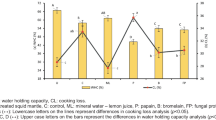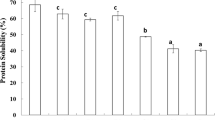Abstract
Effect of the mixture of squid ink tyrosinase (SIT) at 300 and 500 U/g protein and tannic acid (TA) at 0.5 and 1 % (based on protein) with different reaction times (90 and 180 min) on gel properties of sardine surimi was investigated. Surimi gel incorporated with mixture of SIT (500 U/g protein) and 1 % TA with a reaction time of 90 min had the highest breaking force and deformation (p < 0.05), in which the increases by 29.3 % and 11.9 % were observed, in comparison with the control. However, gels added with SIT/TA mixture had the lower whiteness, compared to the control (p < 0.05). Gel added with SIT/TA mixture showed more compact and finer network with higher connectivity of strands, compared to the control. This was coincidental with decreased expressible moisture content. Based on sensory evaluation, the highest overall likeness score was found in gel added with the mixture of SIT (500 U/g protein) and 1 % TA (p < 0.05). Therefore the mixture of tyrosinase from squid ink and tannic acid could be used as additives to improve the properties of surimi gel.




Similar content being viewed by others
References
Balange A, Benjakul S (2009a) Enhancement of gel strength of bigeye snapper (Priacanthus tayenus) surimi using oxidised phenolic compounds. Food Chem 113:61–70
Balange A, Benjakul S (2009b) Effect of oxidised tannic acid on the gel properties of mackerel (Rastrelliger kanagurta) mince and surimi prepared by different washing processes. Food Hydrocoll 23:1693–1701
Balange A, Benjakul S (2011) Effect of kiam wood extract as influenced by pH during oxygenation on mackerel surimi gel. J Food Biochem 35:574–595
Benjakul S, Visessanguan W (2003) Transglutaminase-mediated setting in bigeye snapper surimi. Food Res Int 36:253–266
Benjakul S, Visessanguan W, Srivilai C (2001) Porcine plasma proteins as gel enhancer in bigeye snapper (Priacanthus tayenus) surimi. J Food Biochem 25:285–305
Benjakul S, Visessanguan W, Tueksuban J, Tanaka M (2004) Effect of some protein additives on proteolysis and gel-forming ability of lizardfish (Saurida tumbil). Food Hydrocoll 18:395–401
Benjakul S, Phatcharat S, Tammatinna A, Visessanguan W, Kishimura H (2008) Improvement of gelling properties of lizardfish mince as influenced by microbial transglutaminase and fish freshness. J Food Sci 73:S239–S246
Bittner S (2006) When quinones meet amino acids: chemical, physical and biological consequences. Amino Acids 30:205–224
Buchert J, Cura DE, Ma H, Gasparetti C, Monogioudi E, Faccio G, Mattinen M, Boer H, Partanen R, Selinheimo E, Lantto R, Kruus K (2010) Crosslinking food proteins for improved functionality. Annu Rev of Food Sci Technol 1:113–138
Chaijan M, Benjakul S, Visessanguan W, Faustman C (2004) Characteristics and gel properties of muscles from sardine (Sardinella gibbosa) and mackerel (Rastrelliger kanagurta) caught in Thailand. Food Res Int 37:1021–1030
Chen SC, Chung KT (2000) Mutagenicity and antimutagenicity of tannic acid and its related compounds. Food Chem Toxicol 38:1–5
Gordon JE (1984) The new science of strong materials or why you don’t fall through the flor, 2nd edn. Princeton University Press, New Jersey
Hurrell RF, Finot PA (1984) Nutritional consequences of the reactions between proteins and oxidized polyphenols. Adv Exp Med Biol 177:423–435
Kim YJ, Uyama H (2005) Tyrosinase inhibitors from natural and synthetic sources: structure, inhibition mechanism and perspective for the future. Cell Mol Life Sci 62:1707–1723
Klomklao S, Kishimura S, Benjakul S (2008) Endogenous proteinases in true sardine (Sardinops melanostictus). Food Chem 107:213–220
Ko WC, Yu CC, Hsu KC (2007) Contribution of hydrophobicity, netcharge, and sulfhydryl groups to thermal properties of ovalbumin. LWT-Food Sci Technol 40:1316–1320
Laemmli UK (1970) Cleavage of structural proteins during the assembly of the head of bacteriophage T4. Nature 227:680–685
Lopes GKB, Schulman HM, Hermes-Lima M (1999) Polyphenol tannic acid inhibits hydroxyl radical formation from Fenton reaction by complexing ferrous ions. Biochim Biophys Acta 1472:142–152
Mattinen ML, Lantto R, Selinheimo E, Kruus K, Buchert J (2008) Oxidation of peptides and proteins by Trichoderma reesei and Agaricus bisporus tyrosinases. J Biotechnol 133:395–402
Meilgaard M, Civille GV, Carr BT (1999) Sensory evaluation techniques, 3rd edn. CRC Press, Florida
Monogioudi E, Creusot N, Kruus K, Gruppen H, Buchert J, Mattinen ML (2009) Cross-linking of β-casein by Trichoderma reesei tyrosinase and Streptoverticillium mobaraense transglutaminase followed by SEC–MALLS. Food Hydrocoll 23:2008–2015
Naczk M, Shahidi F (2004) Extraction and analysis of phenolics in food. J Chromatogr A 1054:95–111
NFI (1991) A manual of standard methods for measuring, specifying the properties of surimi. National Fisheries Institute, Washington, DC
Niwa E (1992) Chemistry of surimi gelation. In: Lanier TC, Lee CM (eds) Surimi technology. Marcel Dekker, New York, pp 389–428
O’Connell JE, Fox PF (2001) Significance and applications of phenolic compounds in the production and quality of milk and dairy products. Int Dairy J 11:103–120
Ou S, Wang Y, Tang S, Huang C, Jackson MG (2005) Role of ferulic acid in preparing edible films from soy protein isolate. J Food Eng 70:205–210
Rawdkuen S, Benjakul S, Visessanguan W, Lanier TC (2007) Effect of chicken plasma protein and some protein additives on proteolysis and gel-forming ability of sardine (Sardinella gibbosa) surimi. J Food Process Preserv 31:492–516
Rawdkuen S, Benjakul S, Vissessanguan W, Lanier TC (2008) Effect of cysteine proteinase inhibitor containing fraction from chicken plasma on autolysis and gelation of Pacific whiting surimi. Food Hydrocoll 21:1209–1216
Shitole SS, Balange AK, Gangan SS (2014) Use of seaweed (Sargassum tenerrimum) extract as a gel enhancer for lesser sardine (Sardinella brachiosoma) surimi. Int Aquat Res. doi:10.1007/s40071-014-0055-9
Simpson BK, Marshall MR, Otwell WS (1987) Phenoloxidase from shrimp (Penaues setiferus): Purification and some properties. J Agric Food Chem 35:918–921
Steel RGD, Torrie JH (1980) Principles and procedures of statistics: a biometrical approach, 2nd edn. McGraw-Hill, New York
Strauss G, Gibson SM (2004) Plant phenolics as cross-linkers of gelatin gels and gelatin-based coacervates for use as food ingredients. Food Hydrocoll 18:81–89
Thalmann CR, Lötzbeyer T (2002) Enzymatic cross-linking of proteins with tyrosinase. Eur Food Res Technol 210:276–281
Vate NK, Benjakul S (2013) Antioxidative activity of melanin-free ink from splendid squid (Loligo formosana). Int Aquat Res. doi:10.1186/2008-6970-5-9
Vate NK, Benjakul S, Agustini TW (2014) Application of melanin-free ink as a new antioxidative gel enhancer in sardine surimi gel. J Sci Food Agric 95:2201–2207
Yang Z, Wu F (2006) Catalytic properties of tyrosinase from potato and edible fungi. Biotechnol 5:344–348
Acknowledgments
The authors would like to express their sincere thanks to Prince of Songkla University and the TRF Distinguished Research Professor grant for the financial support.
Author information
Authors and Affiliations
Corresponding author
Rights and permissions
About this article
Cite this article
Vate, N.K., Benjakul, S. Effect of the mixtures of squid ink tyrosinase and tannic acid on properties of sardine surimi gel. J Food Sci Technol 53, 411–420 (2016). https://doi.org/10.1007/s13197-015-1974-1
Revised:
Accepted:
Published:
Issue Date:
DOI: https://doi.org/10.1007/s13197-015-1974-1




